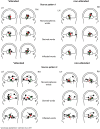The role of attention in processing morphologically complex spoken words: an EEG/MEG study
- PMID: 23316156
- PMCID: PMC3540952
- DOI: 10.3389/fnhum.2012.00353
The role of attention in processing morphologically complex spoken words: an EEG/MEG study
Abstract
This study determined to what extent morphological processing of spoken inflected and derived words is attention-independent. To answer these questions EEG and MEG responses were recorded from healthy participants while they were presented with spoken Finnish inflected, derived, and monomorphemic words. In the non-attended task, the participants were instructed to ignore the incoming auditory stimuli and concentrate on the silent cartoon. In the attended task, previously reported by Leminen et al. (2011), the participants were to judge the acceptability of each stimulus. Importantly, EEG and MEG responses were time-locked to the onset of critical information [suffix onset for the complex words and uniqueness point (UP) for the monomorphemic words]. Early after the critical point, word type did not interact with task: in both attended and non-attended tasks, the event-related potentials (ERPs) showed larger negativity to derived than inflected or monomorphemic words ~100 ms after the critical point. MEG source waveforms showed a similar pattern. Later than 100 ms after the critical point, there were no differences between word types in the non-attended task either in the ERP or source modeling data. However, in the attended task inflected words elicited larger responses than other words ~200 ms after the critical point. The results suggest different brain representations for derived and inflected words. The early activation after the critical point was elicited both in the non-attended and attended tasks. As this stage of word recognition was not modulated by attention, it can be concluded to reflect an automatic mapping of incoming acoustic information onto stored representations. In contrast, the later differences between word types in the attended task were not observed in the non-attended task. This indicates that later compositional processes at the (morpho)syntactic-semantic level require focused attention.
Keywords: ERP; MEG; attention; auditory; derived; inflected; lexicon; morphology.
Figures






Similar articles
-
Differential recall of derived and inflected word forms in working memory: examining the role of morphological information in simple and complex working memory tasks.Front Hum Neurosci. 2015 Jan 15;8:1064. doi: 10.3389/fnhum.2014.01064. eCollection 2014. Front Hum Neurosci. 2015. PMID: 25642181 Free PMC article.
-
Spatiotemporal Dynamics of the Processing of Spoken Inflected and Derived Words: A Combined EEG and MEG Study.Front Hum Neurosci. 2011 Jul 21;5:66. doi: 10.3389/fnhum.2011.00066. eCollection 2011. Front Hum Neurosci. 2011. PMID: 21811451 Free PMC article.
-
Neural dynamics of inflectional and derivational morphology processing in the human brain.Cortex. 2013 Nov-Dec;49(10):2758-71. doi: 10.1016/j.cortex.2013.08.007. Epub 2013 Aug 27. Cortex. 2013. PMID: 24075689
-
Neurocognitive processing of auditorily and visually presented inflected words and pseudowords: evidence from a morphologically rich language.Brain Res. 2009 Jun 12;1275:54-66. doi: 10.1016/j.brainres.2009.03.057. Epub 2009 Apr 9. Brain Res. 2009. PMID: 19362541
-
Neural dynamics of reading morphologically complex words.Neuroimage. 2009 Oct 1;47(4):2064-72. doi: 10.1016/j.neuroimage.2009.06.002. Epub 2009 Jun 8. Neuroimage. 2009. PMID: 19520173
Cited by
-
What Language Disorders Reveal About the Mechanisms of Morphological Processing.Front Psychol. 2021 Nov 29;12:701802. doi: 10.3389/fpsyg.2021.701802. eCollection 2021. Front Psychol. 2021. PMID: 34912261 Free PMC article.
-
Automatic Lexical Access in Visual Modality: Eye-Tracking Evidence.Front Psychol. 2018 Oct 2;9:1847. doi: 10.3389/fpsyg.2018.01847. eCollection 2018. Front Psychol. 2018. PMID: 30333775 Free PMC article.
-
Neural Bases of Proactive and Predictive Processing of Meaningful Subword Units in Speech Comprehension.J Neurosci. 2025 Feb 12;45(7):e0781242024. doi: 10.1523/JNEUROSCI.0781-24.2024. J Neurosci. 2025. PMID: 39562040 Free PMC article.
-
Neurophysiological evidence for whole form retrieval of complex derived words: a mismatch negativity study.Front Hum Neurosci. 2014 Nov 6;8:886. doi: 10.3389/fnhum.2014.00886. eCollection 2014. Front Hum Neurosci. 2014. PMID: 25414658 Free PMC article.
-
Differential recall of derived and inflected word forms in working memory: examining the role of morphological information in simple and complex working memory tasks.Front Hum Neurosci. 2015 Jan 15;8:1064. doi: 10.3389/fnhum.2014.01064. eCollection 2014. Front Hum Neurosci. 2015. PMID: 25642181 Free PMC article.
References
-
- Bertram R., Laine M., Karvinen K. (1999). The interplay of word formation type, affixal homonymy, and productivity in lexical processing: evidence from a morphologically rich language. J. Psycholinguist. Res. 28, 213–226
-
- Bölte J., Jansma B. M., Zilverstrand A., Zwitserlood P. (2009). Derivational morphology approached with event-related potentials. Ment. Lex. 4, 336–353
-
- Bozic M., Marslen-Wilson W. D. (2010). Neurocognitive context for morphological complexity: dissociating inflection and derivation. Lang. Linguist. Compass 4, 1063–1073
LinkOut - more resources
Full Text Sources
Other Literature Sources
Research Materials

